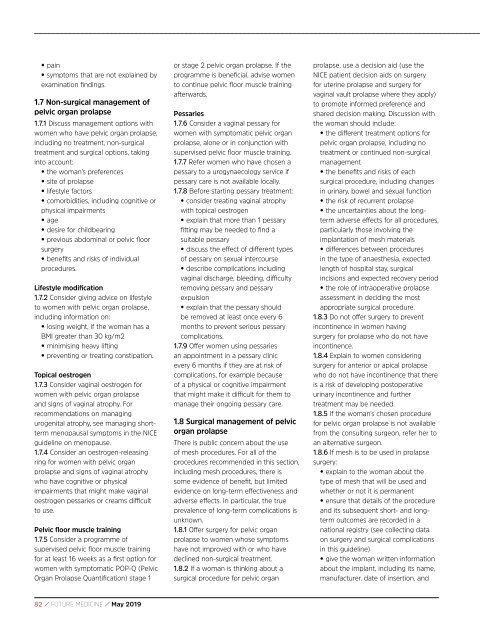may edition file
You also want an ePaper? Increase the reach of your titles
YUMPU automatically turns print PDFs into web optimized ePapers that Google loves.
• pain<br />
• symptoms that are not explained by<br />
examination findings.<br />
1.7 Non-surgical management of<br />
pelvic organ prolapse<br />
1.7.1 Discuss management options with<br />
women who have pelvic organ prolapse,<br />
including no treatment, non-surgical<br />
treatment and surgical options, taking<br />
into account:<br />
• the woman's preferences<br />
• site of prolapse<br />
• lifestyle factors<br />
• comorbidities, including cognitive or<br />
physical impairments<br />
• age<br />
• desire for childbearing<br />
• previous abdominal or pelvic floor<br />
surgery<br />
• benefits and risks of individual<br />
procedures.<br />
Lifestyle modification<br />
1.7.2 Consider giving advice on lifestyle<br />
to women with pelvic organ prolapse,<br />
including information on:<br />
• losing weight, if the woman has a<br />
BMI greater than 30 kg/m2<br />
• minimising heavy lifting<br />
• preventing or treating constipation.<br />
Topical oestrogen<br />
1.7.3 Consider vaginal oestrogen for<br />
women with pelvic organ prolapse<br />
and signs of vaginal atrophy. For<br />
recommendations on managing<br />
urogenital atrophy, see managing shortterm<br />
menopausal symptoms in the NICE<br />
guideline on menopause.<br />
1.7.4 Consider an oestrogen-releasing<br />
ring for women with pelvic organ<br />
prolapse and signs of vaginal atrophy<br />
who have cognitive or physical<br />
impairments that might make vaginal<br />
oestrogen pessaries or creams difficult<br />
to use.<br />
Pelvic floor muscle training<br />
1.7.5 Consider a programme of<br />
supervised pelvic floor muscle training<br />
for at least 16 weeks as a first option for<br />
women with symptomatic POP‐Q (Pelvic<br />
Organ Prolapse Quantification) stage 1<br />
or stage 2 pelvic organ prolapse. If the<br />
programme is beneficial, advise women<br />
to continue pelvic floor muscle training<br />
afterwards.<br />
Pessaries<br />
1.7.6 Consider a vaginal pessary for<br />
women with symptomatic pelvic organ<br />
prolapse, alone or in conjunction with<br />
supervised pelvic floor muscle training.<br />
1.7.7 Refer women who have chosen a<br />
pessary to a urogynaecology service if<br />
pessary care is not available locally.<br />
1.7.8 Before starting pessary treatment:<br />
• consider treating vaginal atrophy<br />
with topical oestrogen<br />
• explain that more than 1 pessary<br />
fitting <strong>may</strong> be needed to find a<br />
suitable pessary<br />
• discuss the effect of different types<br />
of pessary on sexual intercourse<br />
• describe complications including<br />
vaginal discharge, bleeding, difficulty<br />
removing pessary and pessary<br />
expulsion<br />
• explain that the pessary should<br />
be removed at least once every 6<br />
months to prevent serious pessary<br />
complications.<br />
1.7.9 Offer women using pessaries<br />
an appointment in a pessary clinic<br />
every 6 months if they are at risk of<br />
complications, for example because<br />
of a physical or cognitive impairment<br />
that might make it difficult for them to<br />
manage their ongoing pessary care.<br />
1.8 Surgical management of pelvic<br />
organ prolapse<br />
There is public concern about the use<br />
of mesh procedures. For all of the<br />
procedures recommended in this section,<br />
including mesh procedures, there is<br />
some evidence of benefit, but limited<br />
evidence on long-term effectiveness and<br />
adverse effects. In particular, the true<br />
prevalence of long-term complications is<br />
unknown.<br />
1.8.1 Offer surgery for pelvic organ<br />
prolapse to women whose symptoms<br />
have not improved with or who have<br />
declined non-surgical treatment.<br />
1.8.2 If a woman is thinking about a<br />
surgical procedure for pelvic organ<br />
prolapse, use a decision aid (use the<br />
NICE patient decision aids on surgery<br />
for uterine prolapse and surgery for<br />
vaginal vault prolapse where they apply)<br />
to promote informed preference and<br />
shared decision making. Discussion with<br />
the woman should include:<br />
• the different treatment options for<br />
pelvic organ prolapse, including no<br />
treatment or continued non-surgical<br />
management<br />
• the benefits and risks of each<br />
surgical procedure, including changes<br />
in urinary, bowel and sexual function<br />
• the risk of recurrent prolapse<br />
• the uncertainties about the longterm<br />
adverse effects for all procedures,<br />
particularly those involving the<br />
implantation of mesh materials<br />
• differences between procedures<br />
in the type of anaesthesia, expected<br />
length of hospital stay, surgical<br />
incisions and expected recovery period<br />
• the role of intraoperative prolapse<br />
assessment in deciding the most<br />
appropriate surgical procedure.<br />
1.8.3 Do not offer surgery to prevent<br />
incontinence in women having<br />
surgery for prolapse who do not have<br />
incontinence.<br />
1.8.4 Explain to women considering<br />
surgery for anterior or apical prolapse<br />
who do not have incontinence that there<br />
is a risk of developing postoperative<br />
urinary incontinence and further<br />
treatment <strong>may</strong> be needed.<br />
1.8.5 If the woman's chosen procedure<br />
for pelvic organ prolapse is not available<br />
from the consulting surgeon, refer her to<br />
an alternative surgeon.<br />
1.8.6 If mesh is to be used in prolapse<br />
surgery:<br />
• explain to the woman about the<br />
type of mesh that will be used and<br />
whether or not it is permanent<br />
• ensure that details of the procedure<br />
and its subsequent short- and longterm<br />
outcomes are recorded in a<br />
national registry (see collecting data<br />
on surgery and surgical complications<br />
in this guideline)<br />
• give the woman written information<br />
about the implant, including its name,<br />
manufacturer, date of insertion, and<br />
82 / FUTURE MEDICINE / May 2019


















